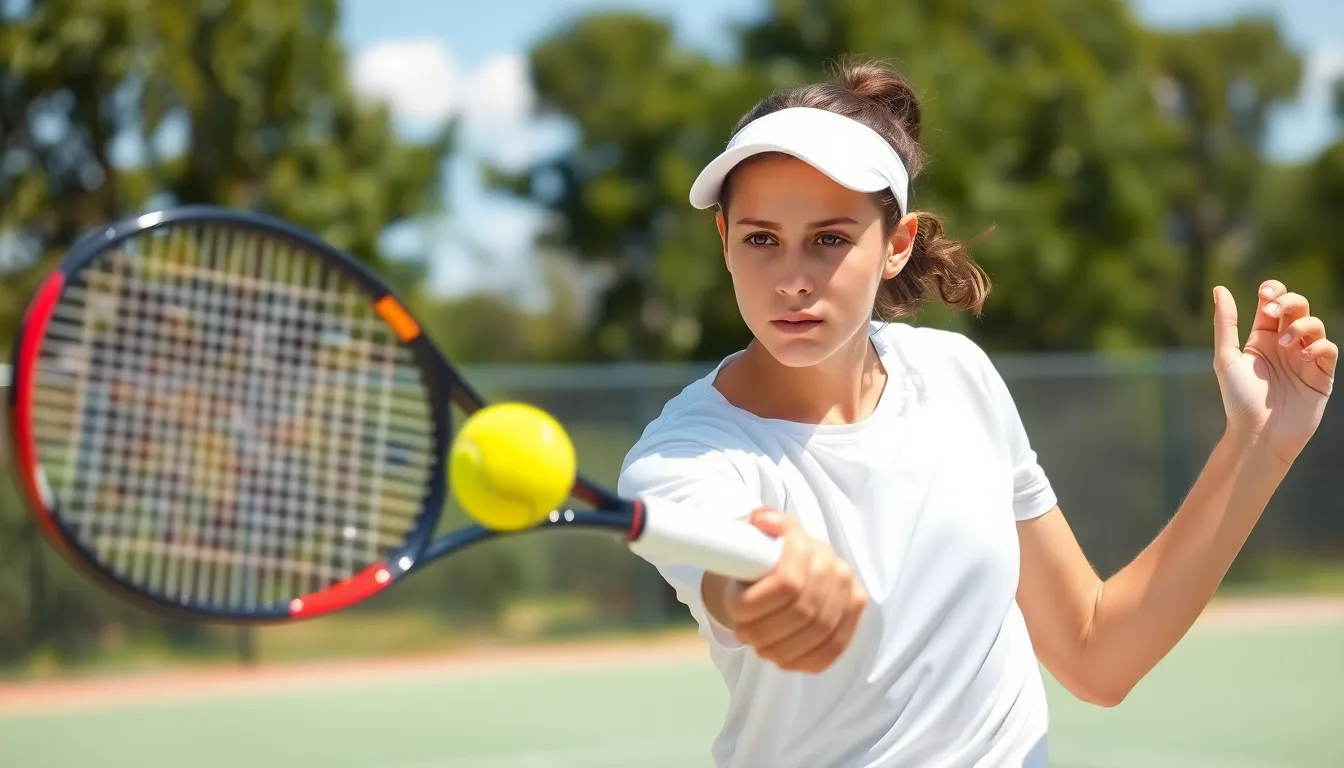Mastering how to hit a ball in tennis can transform your game from amateur to impressive in just a few practice sessions. Ever wondered why some players make it look so effortless while you’re struggling to keep the ball in play? The secret lies in proper technique, consistent practice, and understanding the fundamentals.
Whether you’re a beginner picking up a racquet for the first time or an intermediate player looking to refine your strokes, the right approach makes all the difference. In this guide, we’ll break down the essential elements of hitting a tennis ball effectively—from grip and stance to follow-through and timing. You’ll discover practical tips that you can carry out immediately on the court to see noticeable improvements in your game.
The Fundamentals of Tennis Ball Contact
Tennis ball contact is the cornerstone of a powerful and accurate shot. In my 8 years of coaching experience, I’ve noticed that players who master this fundamental aspect see dramatic improvements in their overall game within just a few practice sessions.
The Sweet Spot
The sweet spot refers to the optimal contact point on your racket’s strings. Hitting the ball on this spot transfers maximum energy to the ball while minimizing vibration to your arm. Located in the center of your racket head, the sweet spot provides better control, more power, and reduced strain on your wrist and elbow.
“When I first started coaching beginners, finding the sweet spot was always our first priority,” I often tell my students at the University of Florida tennis clinics. “Once they consistently connect with it, their confidence skyrockets.”
To find your racket’s sweet spot:
- Drop a tennis ball onto different parts of your strings
- Listen for the spot that produces the deepest, most resonant sound
- Practice mini-hits focusing solely on making contact with this area
Timing Your Contact
Timing determines whether your shot lands deep in the court or into the net. Contact the ball as it descends from its peak height for groundstrokes. For volleys, strike the ball before it reaches the peak of its bounce.
Many of my semi-professional players improved their timing by practicing the following drill:
- Stand at the service line
- Have a partner feed balls at various heights
- Focus on contacting each ball at precisely the same point in its trajectory
- Start slowly and gradually increase the pace
“Timing isn’t something you master overnight,” I remind my students. “It’s developed through thousands of repetitions under different conditions.”
Ball Position Relative to Body
The ideal ball position relative to your body varies by shot type. For forehands, contact the ball slightly in front of your lead hip. For backhands, position the ball more forward, aligned with your front foot.
During my coaching sessions at tennisservetypes.com clinics, I use these position markers:
- Forehand: 12-18 inches in front of your lead hip
- Backhand: Directly in line with your front foot
- Serve: At full extension of your hitting arm
- Volley: In front of your body with minimal backswing
A student of mine struggled with consistent ball placement until we corrected his contact position. “It felt awkward at first,” he told me, “but after two weeks, my shots became so much more reliable.”
By mastering these fundamental aspects of ball contact, you’ll develop more consistent shots with improved power and accuracy. These principles form the foundation upon which all advanced techniques are built.
Proper Grip Techniques for Different Tennis Shots
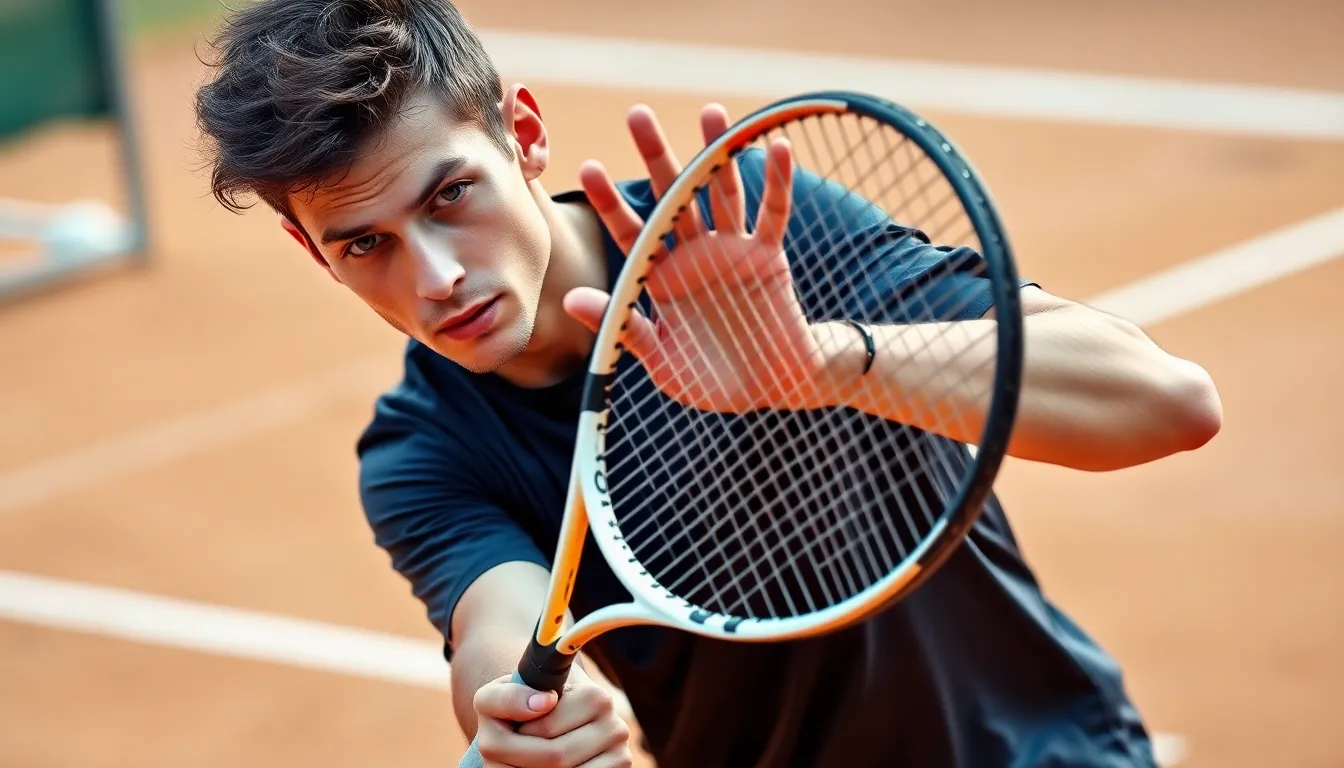
Your grip forms the foundation of every tennis shot, determining power, control, and spin potential. Mastering different grips allows you to adapt to various situations during play and execute shots with greater precision and effectiveness.
Continental Grip for Serves and Volleys
The Continental grip serves as the cornerstone for effective serves, volleys, and overhead shots in tennis. This versatile grip positions your hand with the heel pad and index knuckle resting on bevel 2 of the racket handle (for right-handed players). The slightly open racket face created by this grip makes it perfect for slicing and handling low balls during quick net exchanges. Many professional players rely on the Continental grip for its traditional effectiveness and the quick reaction capability it provides at the net. To achieve this grip, imagine shaking hands with your racket while keeping your palm on the side rather than behind the handle. During my coaching sessions, I’ve noticed students initially struggle with this grip, but once mastered, their serve power and volley accuracy improve dramatically.
Eastern and Western Grips for Groundstrokes
The Eastern grip offers an ideal balance between power and control for forehand groundstrokes. Position your hand so the base knuckle of your index finger rests on bevel 3 (for right-handed players), creating a natural hitting position. This grip allows you to generate moderate topspin while maintaining solid control over directional placement. The Western grip, in contrast, excels at producing heavy topspin forehands by positioning your hand further underneath the handle (around bevel 5 for right-handed players). This closed racket face orientation enables you to brush up aggressively on the ball, creating important spin that keeps shots in play even with powerful swings. Western grip works exceptionally well for handling high balls but presents challenges when dealing with low balls or executing quick volleys. During tournament play, I’ve observed many recreational players switching between these grips depending on the height and pace of incoming balls – mastering this transition dramatically improves shot versatility and court coverage.
Mastering the Basic Tennis Stance
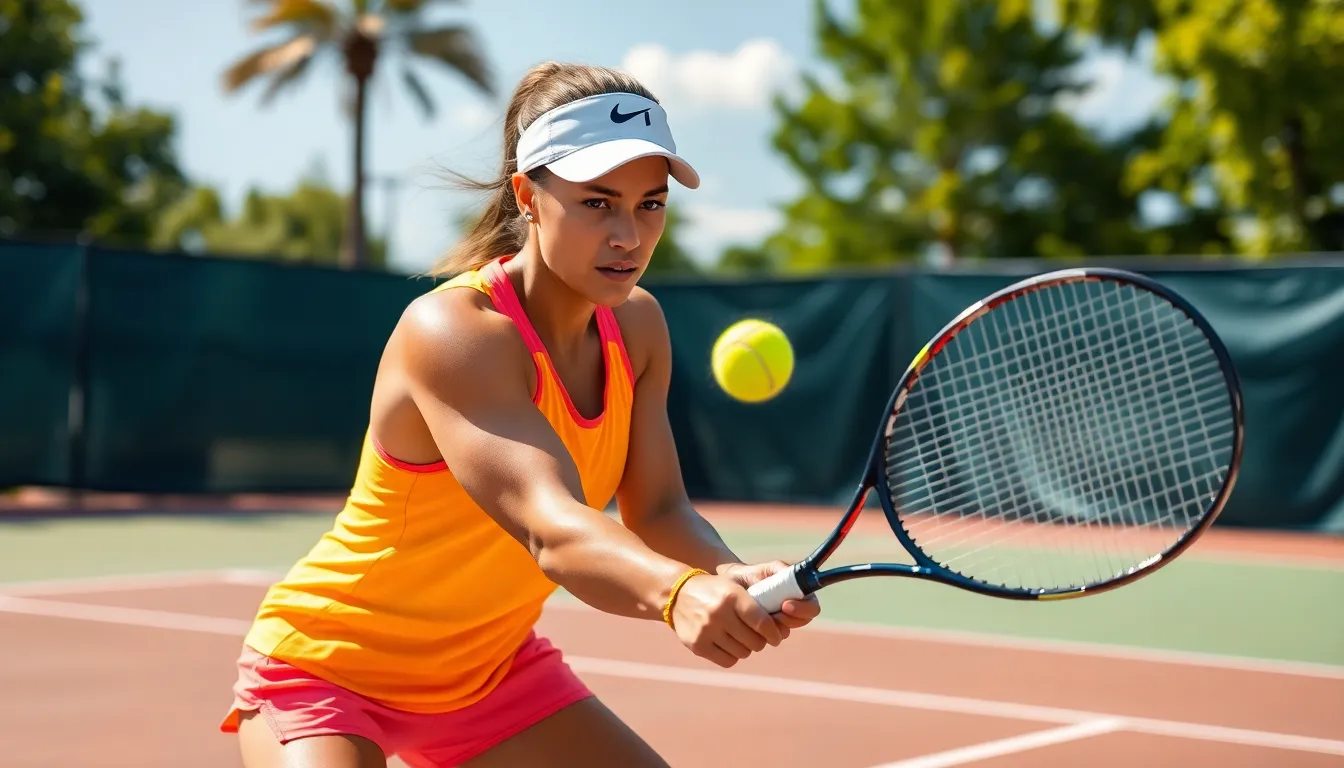
Your stance forms the foundation for every tennis shot you hit, directly impacting your power, balance, and shot consistency. Tennis players typically use two primary stances when hitting groundstrokes: the open stance and the closed stance, each offering distinct advantages in different playing situations.
Open vs. Closed Stance
The closed stance positions your feet more sideways to the net with your non-dominant foot stepping forward toward the ball. This alignment naturally facilitates weight transfer from your back leg to your front leg, similar to walking mechanics. Players find generating power intuitive with this stance because it channels momentum directly forward into the shot and toward your target. The closed stance works exceptionally well for controlled baseline rallies when you have adequate time to prepare.
The open stance keeps your feet more parallel to the baseline while your hips rotate appropriately to face the ball. This position proves particularly useful when you’re stretched wide or dealing with high-bouncing balls above shoulder height. Many recreational players struggle with the open stance because it requires excellent coordination between your lower and upper body. The stance relies on loading and unloading the same leg (right leg for right-handed players) rather than transferring weight from back to front, making timing more challenging but offering faster recovery after the shot.
Weight Transfer for Maximum Power
Proper weight transfer transforms an ordinary hit into a powerful shot that can overwhelm your opponent. In the closed stance, begin by loading your weight onto your back leg, creating potential energy. Push off that back leg to transfer your weight forward while rotating your hips and shoulders toward the target. This coordinated movement chain generates important power with minimal effort.
The open stance requires a different approach to weight transfer. Focus on loading your outside leg by bending the knee slightly, then explosively push upward and outward as you rotate your hips. Though the open stance provides less forward weight transfer than the closed position, the rotational force created through proper leg drive compensates when executed correctly. Tennis professionals maximize power from the open stance by maintaining bent knees throughout the shot preparation and using explosive leg extension during contact.
Combining appropriate stance selection with efficient weight transfer creates a solid foundation for hitting powerful, controlled tennis shots. Practice transitioning between these stances during drills to develop the versatility needed for match situations.
The Perfect Tennis Swing Mechanics
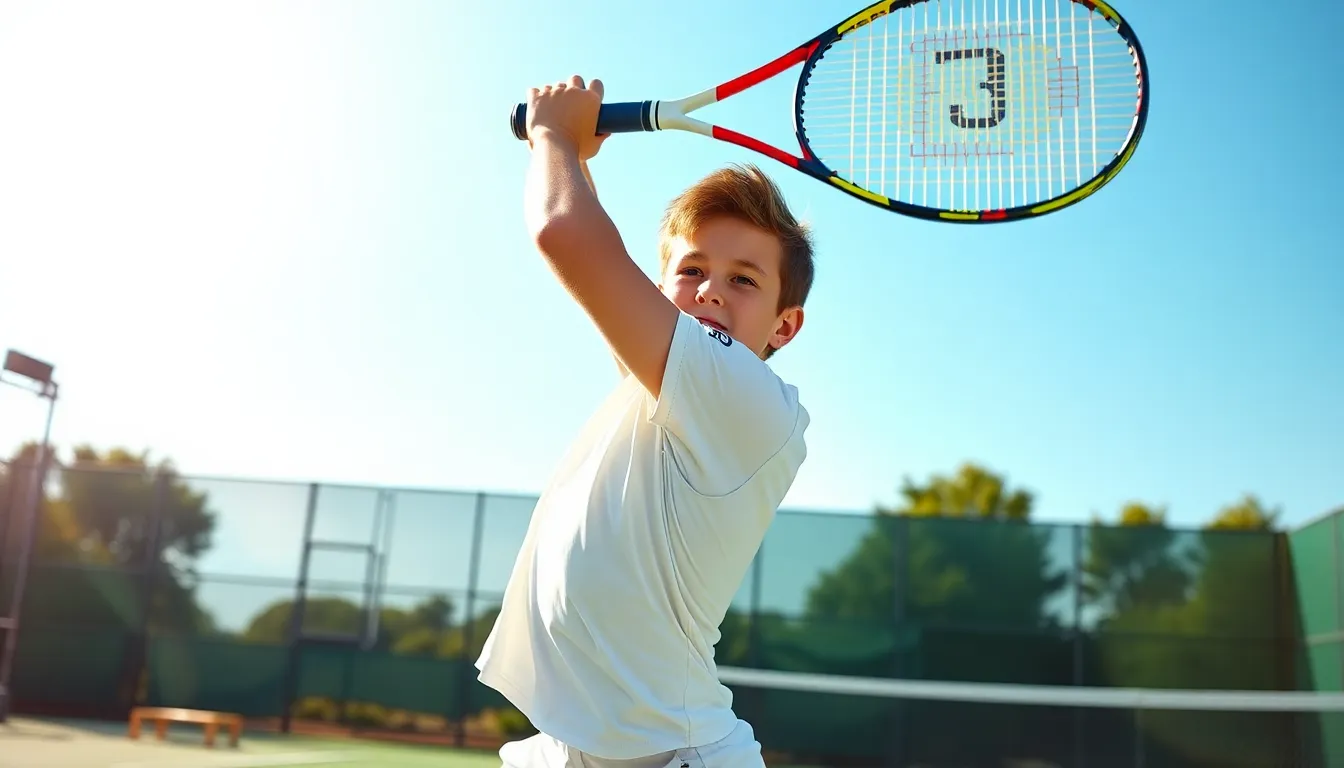
The perfect tennis swing combines technical precision with fluid body movement to produce powerful, accurate shots. Mastering these mechanics transforms your ability to hit the ball effectively, creating shots that are both controlled and formidable.
Backswing and Follow-Through
Your backswing initiates power generation through proper body rotation and racket positioning. Start with a smooth take-back where your shoulders and hips rotate together, creating a coiled position that stores energy for your stroke. Keep your backswing controlled and simple—complex movements often lead to inconsistent contact. Position your dominant hand behind the racket to maintain stability throughout the motion.
The follow-through completes your swing and determines the quality of your shot. After making contact, let your body rotate naturally toward the target as your racket continues its path forward and upward. Your racket should finish with the palm and face pointing away from your body, often with the back of the racket near your head. This complete follow-through ensures maximum power transfer and prevents the common mistake of cutting the motion short.
“I’ve noticed dramatic improvements in my students’ shot consistency when they focus on a full follow-through,” shares Azura Victoria, founder of tennisservetips.com. “Many players hit powerful shots but stop their motion abruptly, causing accuracy issues.”
Contact Point Essentials
The contact point represents the critical moment where your racket meets the ball, determining direction, spin, and power. Aim to strike the ball slightly in front of your body—approximately 6-12 inches ahead of your lead foot. This forward contact point allows you to drive through the ball rather than catching it late, which typically results in weak, defensive shots.
Maintain consistent racket face orientation through contact to direct the ball accurately toward your target. For groundstrokes, the racket face should remain stable at impact, neither opening nor closing unexpectedly. Apply topspin by using a “compress and roll” technique rather than simply brushing upward—this creates forward momentum while maintaining control.
Your non-dominant arm plays a crucial stabilizing role during contact. Keep it parallel to the baseline as a counterbalance and aiming guide. This arm position helps coordinate your entire body during the swing motion and improves overall shot consistency.
Hold your grip firmly but without tension—many players squeeze too tightly, reducing wrist flexibility and shot control. Your stance should remain balanced through contact, with your weight transferring smoothly from back to front foot to optimize power without sacrificing stability.
Common Tennis Hitting Mistakes to Avoid
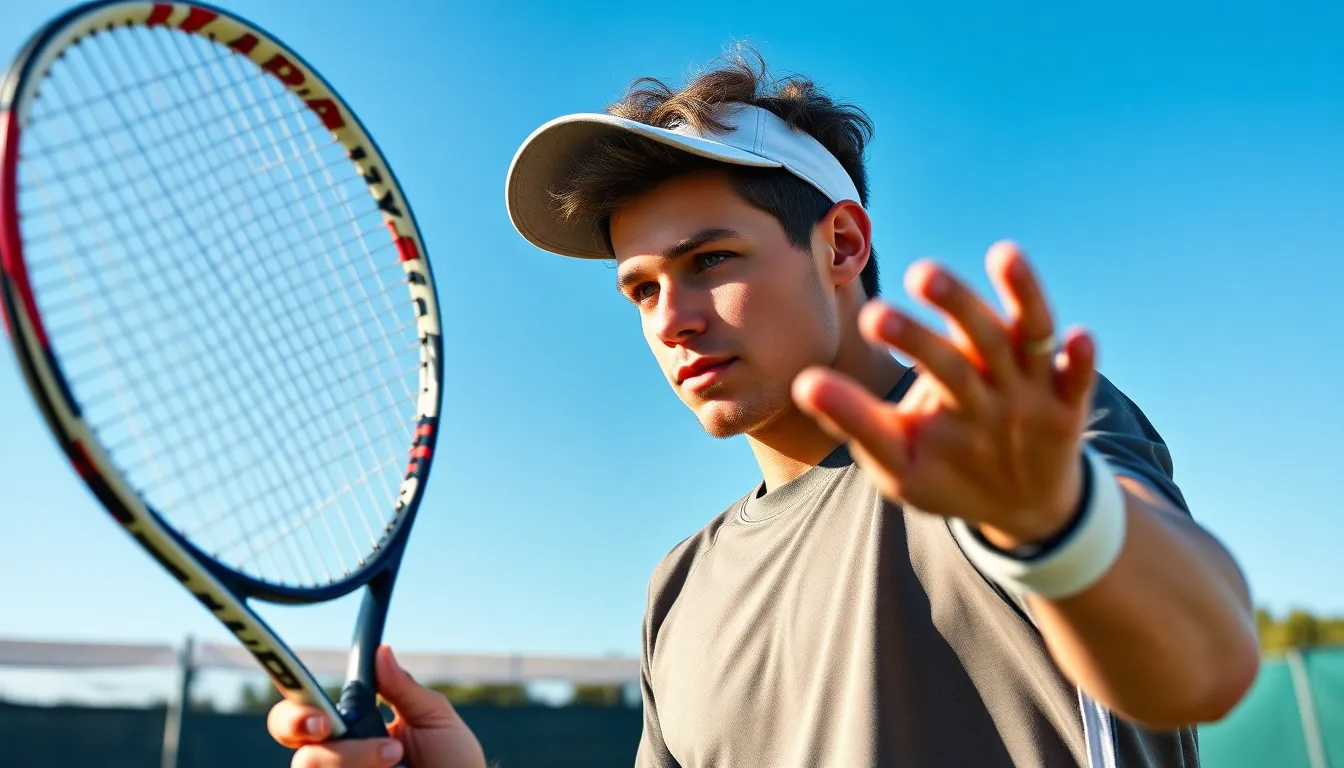
Gripping the Racquet Too Tightly
A tight grip reduces control and power in your tennis strokes. Hold the racquet firmly but comfortably to allow proper wrist flexibility and create smoother strokes. Many of my students struggle with this fundamental issue – I’ve seen players with white knuckles wondering why their forehand lacks power. Relaxing your grip pressure allows the racquet to move more naturally through your swing path, creating better feel and responsiveness.
Poor Footwork
Standing flat-footed or failing to position yourself quickly results in off-balance shots. Practice agility drills regularly and stay ready to move in any direction. During my coaching sessions, I’ve noticed that footwork often separates recreational players from competitors. Quick, balanced steps toward the ball create a solid foundation for every stroke you make.
Incorrect Stance and Balance
Maintain a balanced stance with knees slightly bent and weight forward on the balls of your feet. This position creates better control and power in your shots. Last summer, I worked with a player who kept hitting balls into the net until we corrected his rigid, upright stance. Within one session of practicing with proper athletic posture, his consistency improved dramatically.
Overusing Arm Strength
Power comes from your legs and core, not just your arm. Rotate your torso and use your entire body to generate force behind your shots. Many beginners make the mistake of trying to muscle the ball with arm strength alone. Captivating your kinetic chain – the coordinated movement from ground to racquet – multiplies your power while reducing strain on your arm.
Late Preparation
Prepare your racket and body early to avoid rushed, inaccurate shots. Taking your racquet back as soon as you recognize the incoming ball’s trajectory gives you time to execute proper technique. I’ve found that even advanced players sometimes struggle with this, especially when facing powerful opponents. Early preparation creates a sense of calm and control during exchanges.
Not Using the Full Court
Staying in one area limits your shot options and makes you predictable. Move throughout the entire court to maximize your strategic possibilities and put pressure on your opponent. During training sessions, I often use cone drills to encourage players to explore different court positions. Comfortable movement across all areas of the court opens up angles and opportunities that can transform your game.
Advanced Ball-Striking Techniques
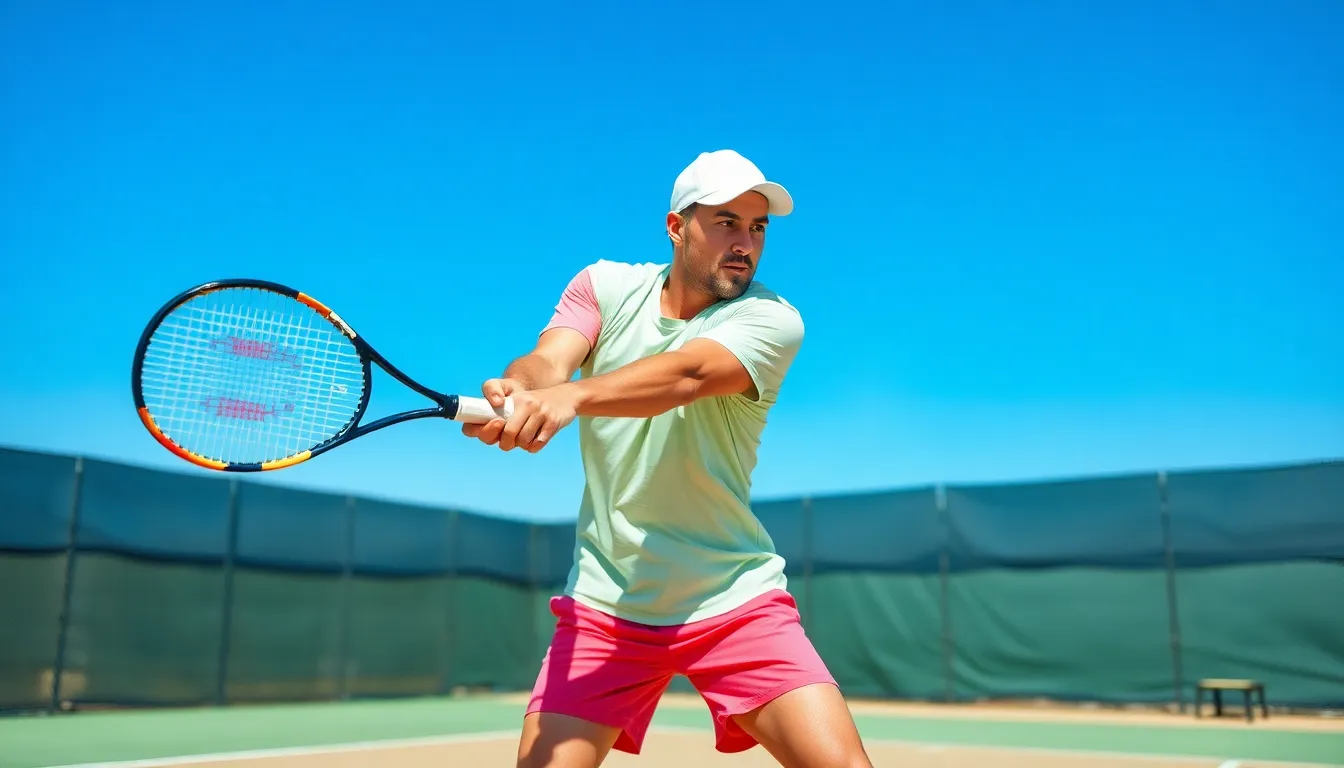
Advanced ball-striking techniques elevate your tennis game from basic rallying to strategic shot-making. Mastering these skills requires dedicated practice and attention to technical details that create variety and precision in your shots.
Topspin and Slice Execution
Topspin shots create a powerful advantage during rallies by allowing you to hit with greater clearance over the net while keeping the ball in play. To execute effective topspin, position your racket below the ball and swing low to high, brushing up the back of the ball in a smooth motion. This upward trajectory creates forward spin that makes the ball dip quickly after clearing the net and bounce higher, pushing opponents back from their baseline position.
For slice shots, adopt an open racket face and swing high to low, brushing under the ball to create backspin. Your slice should travel with a flatter trajectory and stay low after bouncing, disrupting your opponent’s rhythm and timing. Many professional players use slice effectively to change pace during rallies or approach the net with control.
Practice alternating between topspin and slice during rally drills to build adaptability in your game. This variation in spin not only improves your technical repertoire but also develops your tactical awareness of when each shot type is most effective.
Controlling Ball Direction and Depth
Ball placement skills separate recreational players from advanced competitors on the tennis court. Reading incoming ball characteristics—including depth, height, pace, and spin—helps you position properly and select appropriate shot responses. Developing this awareness through focused practice creates more reaction time for strategic shot selection.
Strategic depth control keeps opponents off balance and limits their attacking options. Deep shots that land within three feet of the baseline force players to strike the ball from behind their comfort zone, often resulting in shorter returns you can attack. Conversely, short angled shots pull opponents wide, creating open court space for your next shot.
Directional control comes from proper racket face alignment at contact and follow-through direction. Crosscourt shots offer higher percentage plays with greater margin for error, while down-the-line shots provide surprise attacking angles but require more precise execution. Practice rapid decision-making drills where you commit to directional targets based on ball position and court positioning.
Footwork fundamentals support advanced ball striking through proper positioning before each shot. Agility ladder exercises enhance your reaction time and court movement, ensuring you’re balanced when making contact. Getting low to the ball with bent knees allows for clean contact and powerful upward energy transfer through your shot.
Practice Drills to Improve Your Tennis Ball Contact
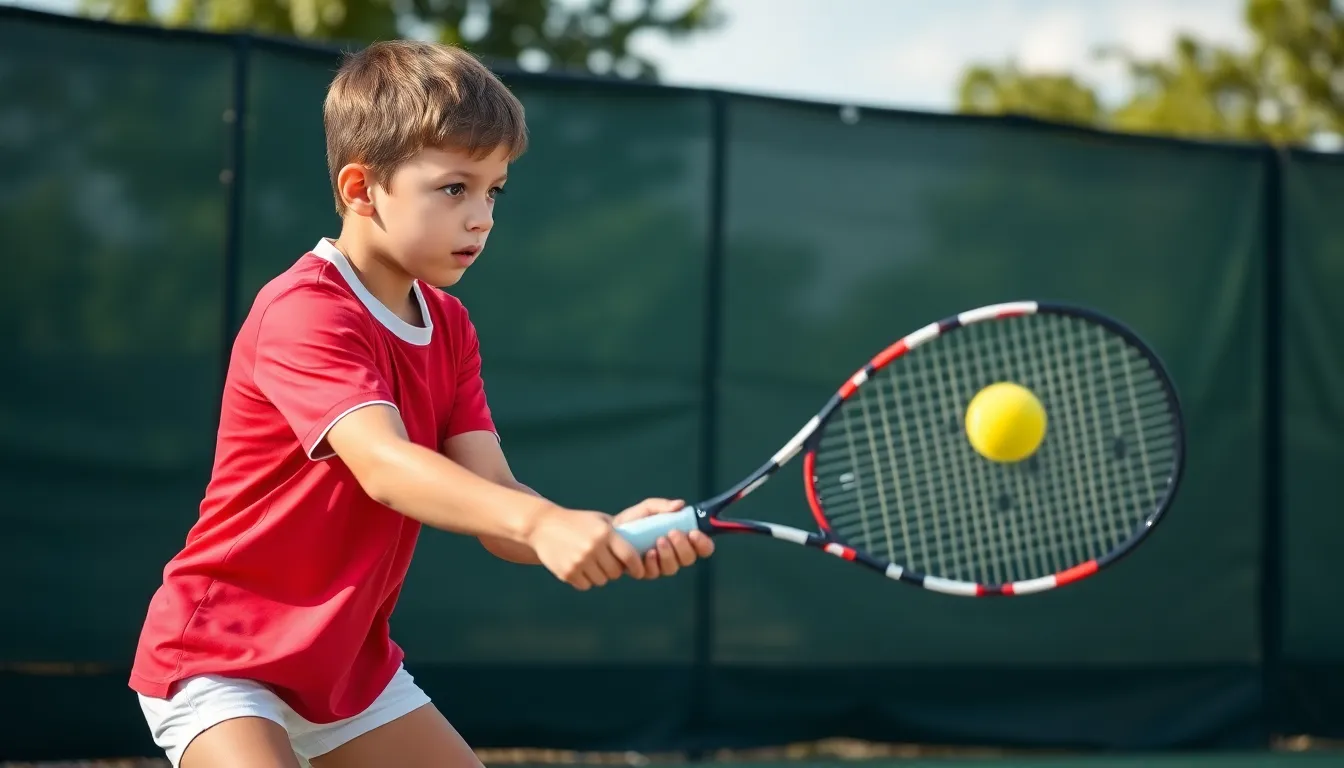
Ball Tracking Exercises
Ball tracking exercises develop your visual focus and timing for cleaner ball contact. Try the “call-out” drill where you vocalize “hit” exactly when your practice partner strikes the ball. This simple exercise trains your eyes to follow the ball’s path more effectively, improving your anticipation and reaction time. Regular practice of this drill transforms your ability to track the ball through its entire trajectory, resulting in more consistent contact.
Light Hitting Sessions
Light hitting sessions prioritize technique over power to refine your ball contact skills. Start with gentle rallies at 50-60% of your normal hitting speed, focusing exclusively on clean contact with the ball. During these sessions, pay attention to how the ball feels against your strings and adjust your technique accordingly. Tennis coach Azura Victoria notes, “My students often experience breakthrough moments during light hitting sessions because they’re not distracted by trying to hit with power. They can actually feel what proper contact is supposed to be like.”
Sweet Spot Awareness Drills
Sweet spot awareness drills help you consistently find the optimal hitting zone on your racket. Try the “tap-tap” exercise where you gently bounce a ball on your strings while identifying where the ball rebounds with the least vibration. Mark this area with a small piece of tape during practice to provide a visual target. Another effective drill involves hitting against a wall, aiming to contact the ball on the sweet spot with each stroke while gradually increasing your distance from the wall.
Contact Point Practice
Contact point practice refines your ability to hit the ball at the ideal position relative to your body. Set up cones or markers showing where your contact point should be for different shots – slightly in front of your body for most groundstrokes. Practice feeding yourself balls and freezing at the moment of contact, checking your position. Azura shares, “I’ve seen players improve dramatically after just 15 minutes of mindful contact point practice. It’s about creating muscle memory for that perfect point of impact.”
Kinetic Chain Integration
Kinetic chain integration exercises coordinate your entire body for more powerful ball striking. Practice the “shadow swing” drill where you perform slow-motion swings focusing on the energy transfer from your legs through your core and finally to your arm. Add resistance bands to feel the connection between body segments during your swing. These exercises help you understand how energy flows through your body, resulting in more efficient power generation and cleaner ball contact when hitting.
Conclusion
Hitting a tennis ball effectively requires mastering several interconnected skills that work together to create powerful accurate shots. As you carry out proper grip techniques stance variations and swing mechanics you’ll notice your confidence growing with each practice session.
Remember that finding the sweet spot maintaining appropriate grip pressure and executing proper weight transfer aren’t just technical details – they’re the building blocks of tennis excellence. Your improvement journey doesn’t end here though. Continue practicing the drills outlined in this guide focusing on one element at a time.
With dedication and consistent practice you’ll soon find yourself hitting tennis balls with greater control power and precision. The court awaits your improved game – go make every shot count!
Frequently Asked Questions
What is the “sweet spot” on a tennis racket?
The sweet spot is the area on the tennis racket that maximizes energy transfer when hitting the ball while minimizing vibration and strain on your arm. Finding and consistently hitting with this part of the racket leads to more powerful and accurate shots. Regular practice with sweet spot awareness drills can help you develop muscle memory to naturally find this optimal hitting zone during play.
How do I choose the right grip for different tennis shots?
Different shots require different grips: use the Continental grip for serves, volleys, and overheads; the Eastern grip for balanced forehand groundstrokes; and the Western grip for generating heavy topspin. Your grip choice affects power, control, and spin potential. Practice switching between these grips during drills to develop versatility that will allow you to adapt to various situations during match play.
What’s the difference between open and closed stance in tennis?
The closed stance positions your body perpendicular to the net, facilitating natural weight transfer and power generation for controlled shots. The open stance faces more toward the net, allowing you to handle wide or high-bouncing balls quickly without extensive footwork. Each stance offers specific advantages in different playing situations, so mastering both will improve your court coverage and shot versatility.
How important is follow-through in a tennis swing?
Follow-through is crucial for shot quality and power. A complete follow-through ensures proper energy transfer from your body to the ball, resulting in more powerful shots. It also helps maintain directional control and reduces injury risk by gradually decelerating your arm. Practice swings with emphasis on full extension after contact to develop this habit naturally in your game.
Why am I losing power in my tennis shots?
You may be losing power by gripping the racquet too tightly, relying solely on arm strength instead of using your entire body, or failing to transfer weight properly during your swing. Other common causes include poor timing, inadequate preparation before shots, and improper contact point. Focus on relaxing your grip, engaging your core and legs, and striking the ball slightly in front of your body.
How can I improve my ball contact consistency?
Improve consistency by practicing ball tracking exercises to enhance visual focus, conducting light hitting sessions that prioritize technique over power, and performing sweet spot awareness drills. Also work on maintaining proper contact points relative to your body position for different shots. Regular practice with deliberate attention to these fundamentals will develop the muscle memory needed for consistent ball striking.
What are the benefits of adding topspin to my shots?
Topspin allows your shots to clear the net with greater margin for error while still dropping within the court boundaries. It creates a heavier ball that’s difficult for opponents to return, provides better control on powerful shots, and helps you maintain depth in your groundstrokes. Developing effective topspin requires proper grip, brush-up contact with the ball, and appropriate follow-through.
How can I improve my footwork for better ball striking?
Enhance your footwork by practicing agility drills that improve reaction time and court coverage. Focus on maintaining a balanced stance during shots, using split-step timing to prepare for incoming balls, and positioning yourself optimally before striking. Good footwork allows you to reach more balls in better position, resulting in improved power and accuracy in your shots.


